Continued Reforestation and Urban Expansion in the New Century of a Tropical Island in the Caribbean
Abstract
:1. Introduction
2. Materials and Methods
2.1. Study Area
2.2. Data Preprocessing
2.3. Reference Data Collection
2.4. Land Cover Mapping, Post Classification, and Land Change Analyses
3. Results
3.1. Land Cover Classifications in 2000 and 2010
3.2. Land Cover Changes between the Years of 2000 and 2010
3.3. Spatial Distribution of Forest Changes from 2000 to 2010
3.4. LCLUC Along the Slope Gradient
3.5. LCLUC Within and Surrounding the Protected Areas
4. Discussion
4.1. Land Cover Land Use Mapping in the Tropics
4.2. Patterns in Land Cover Land Use Changes
5. Conclusions
Acknowledgments
Author Contributions
Conflicts of Interest
Appendix A
| Land Cover | Abbreviation | Description | # Samples in 2000 | # Samples in 2010 |
|---|---|---|---|---|
| Montane woodland | MTWD | Woody (coffee) plantation, low-density woodland in mountain areas, canopy coverage below 50% | 65 | 150 |
| Bare ground | BARE | Non-forested and non-agricultural land with less than 10% herbaceous cover, including sparsely vegetated land, bare soil, bedrock, volcanic material, coastal sand dunes | 107 | 57 |
| Closed shrubland | CLSH | High-density shrubs, scrub generally below 3 m in height, canopy coverage around 30%–50% | 45 | 104 |
| Herbaceous agriculture/pasture | HERB | Herbaceous vegetation such as crops, pasture, and marsh, tree and shrub coverage less than 10% | 560 | 659 |
| Forest | FORS | High-density scrub with more than 50% canopy coverage, trees with 3 m or more in height, including both deciduous and evergreen forests | 605 | 621 |
| Urban | URBN | Urban development, including residential, commercial, industrial, transportation and utility infrastructure, green belt (width less than 30 m), and other developed land | 198 | 191 |
| Forested Wetland | FWET | Forested wetland, including mangroves and Pterocarpus forest | 180 | 190 |
| Water | WATR | Inland water bodies (natural & artificial) including reservoirs, lakes, rivers, lagoons, and drainages. | 95 | 95 |
| Coastal woodland | FTWD | Coastal low-density woodland on flat land, including fruit trees, canopy coverage below 50% | 112 | 116 |
| C1 | MTWD | BARE | CLSH | FORS | HERB | URBN | FWET | WATR | FTWD | UA |
| MTWD | 39 | 0 | 0 | 3 | 1 | 0 | 0 | 0 | 0 | 90.7% |
| BARE | 0 | 7 | 1 | 0 | 0 | 1 | 0 | 0 | 0 | 77.8% |
| CLSH | 1 | 0 | 22 | 2 | 2 | 1 | 0 | 0 | 1 | 75.9% |
| FORS | 2 | 0 | 1 | 178 | 0 | 0 | 2 | 0 | 8 | 93.2% |
| HERB | 1 | 1 | 3 | 1 | 180 | 3 | 0 | 0 | 5 | 92.8% |
| URBN | 0 | 1 | 0 | 0 | 7 | 38 | 0 | 0 | 0 | 82.6% |
| FWET | 0 | 0 | 0 | 0 | 0 | 0 | 46 | 0 | 0 | 100.0% |
| WATR | 0 | 0 | 0 | 0 | 0 | 0 | 0 | 25 | 0 | 100.0% |
| FTWD | 0 | 0 | 3 | 1 | 3 | 0 | 1 | 0 | 19 | 70.4% |
| PA | 90.7% | 77.8% | 73.3% | 96.2% | 93.3% | 88.4% | 93.9% | 100.0% | 57.6% | |
| C2 | MTWD | BARE | CLSH | FORS | HERB | URBN | FWET | WATR | FTWD | UA |
| MTWD | 39 | 0 | 0 | 3 | 1 | 0 | 0 | 0 | 0 | 90.7% |
| BARE | 0 | 9 | 1 | 0 | 2 | 0 | 0 | 0 | 0 | 75.0% |
| CLSH | 1 | 0 | 20 | 2 | 1 | 0 | 0 | 0 | 1 | 80.0% |
| FORS | 2 | 0 | 1 | 177 | 1 | 0 | 2 | 0 | 6 | 93.7% |
| HERB | 1 | 0 | 4 | 1 | 180 | 3 | 0 | 0 | 5 | 92.8% |
| URBN | 0 | 0 | 0 | 0 | 6 | 40 | 0 | 0 | 0 | 87.0% |
| FWET | 0 | 0 | 0 | 0 | 0 | 0 | 46 | 0 | 0 | 100.0% |
| WATR | 0 | 0 | 0 | 0 | 0 | 0 | 0 | 25 | 0 | 100.0% |
| FTWD | 0 | 0 | 4 | 2 | 2 | 0 | 1 | 0 | 21 | 70.0% |
| PA | 90.7% | 100.0% | 66.7% | 95.7% | 93.3% | 93.0% | 93.9% | 100.0% | 63.6% | |
| C3 | MTWD | BARE | CLSH | FORS | HERB | URBN | FWET | WATR | FTWD | UA |
| MTWD | 40 | 0 | 0 | 3 | 0 | 0 | 0 | 0 | 0 | 93.0% |
| BARE | 0 | 9 | 0 | 0 | 0 | 1 | 0 | 0 | 0 | 90.0% |
| CLSH | 0 | 0 | 20 | 1 | 2 | 0 | 0 | 0 | 5 | 71.4% |
| FORS | 1 | 0 | 0 | 178 | 1 | 0 | 2 | 0 | 4 | 95.7% |
| HERB | 2 | 0 | 4 | 1 | 186 | 9 | 1 | 0 | 2 | 90.7% |
| URBN | 0 | 0 | 1 | 0 | 3 | 33 | 0 | 0 | 0 | 89.2% |
| FWET | 0 | 0 | 0 | 0 | 0 | 0 | 46 | 0 | 1 | 97.9% |
| WATR | 0 | 0 | 0 | 0 | 0 | 0 | 0 | 25 | 0 | 100.0% |
| FTWD | 0 | 0 | 5 | 2 | 1 | 0 | 0 | 0 | 21 | 72.4% |
| PA | 93.0% | 100.0% | 66.7% | 96.2% | 96.4% | 76.7% | 93.9% | 100.0% | 63.6% | |
| C4 | MTWD | BARE | CLSH | FORS | HERB | URBN | FWET | WATR | FTWD | UA |
| MTWD | 38 | 0 | 0 | 2 | 1 | 0 | 0 | 0 | 0 | 92.7% |
| BARE | 0 | 9 | 1 | 0 | 2 | 0 | 0 | 0 | 0 | 75.0% |
| CLSH | 2 | 0 | 20 | 0 | 5 | 1 | 0 | 0 | 2 | 66.7% |
| FORS | 2 | 0 | 1 | 178 | 1 | 0 | 2 | 0 | 4 | 94.7% |
| HERB | 1 | 0 | 4 | 1 | 184 | 2 | 1 | 0 | 2 | 94.4% |
| URBN | 0 | 0 | 0 | 0 | 0 | 40 | 0 | 0 | 0 | 100.0% |
| FWET | 0 | 0 | 0 | 1 | 0 | 0 | 46 | 0 | 1 | 95.8% |
| WATR | 0 | 0 | 0 | 0 | 0 | 0 | 0 | 25 | 0 | 100.0% |
| FTWD | 0 | 0 | 4 | 3 | 0 | 0 | 0 | 0 | 24 | 77.4% |
| PA | 88.4% | 100.0% | 66.7% | 96.2% | 95.3% | 93.0% | 93.9% | 100.0% | 72.7% | |
| C5 | MTWD | BARE | CLSH | FORS | HERB | URBN | FWET | WATR | FTWD | UA |
| MTWD | 40 | 0 | 0 | 2 | 0 | 0 | 0 | 0 | 0 | 95.2% |
| BARE | 0 | 9 | 1 | 0 | 0 | 0 | 0 | 0 | 0 | 90.0% |
| CLSH | 1 | 0 | 21 | 0 | 3 | 0 | 0 | 0 | 5 | 70.0% |
| FORS | 1 | 0 | 2 | 179 | 1 | 0 | 2 | 0 | 4 | 94.7% |
| HERB | 1 | 0 | 3 | 1 | 187 | 4 | 1 | 0 | 2 | 94.0% |
| URBN | 0 | 0 | 0 | 0 | 0 | 39 | 0 | 0 | 0 | 100.0% |
| FWET | 0 | 0 | 0 | 0 | 0 | 0 | 46 | 0 | 1 | 97.9% |
| WATR | 0 | 0 | 0 | 0 | 0 | 0 | 0 | 25 | 0 | 100.0% |
| FTWD | 0 | 0 | 3 | 3 | 2 | 0 | 0 | 0 | 21 | 72.4% |
| PA | 93.0% | 100.0% | 70.0% | 96.8% | 96.9% | 90.7% | 93.9% | 100.0% | 63.6% |
| From Bare Ground | From Herbaceous Cover | From Woodland | |||||||
|---|---|---|---|---|---|---|---|---|---|
| DF | MF | WF | DF | MF | WF | DF | MF | WF | |
| IPA (km2) | 0.1 | 0.06 | 0.09 | 2.4 | 4.8 | 1.7 | 4.7 | 4.3 | 5.1 |
| OPA500m (km2) | 0.1 | 0.1 | 0.1 | 2.4 | 7.9 | 6.0 | 4.6 | 6.0 | 9.8 |
| OPA1km (km2) | 0.2 | 0.2 | 0.1 | 5.6 | 14.0 | 13.3 | 9.0 | 11.2 | 18.5 |
| IPA (%) | 1.6 | 7.3 | 68.0 | 8.2 | 21.4 | 43.5 | 22.2 | 42.1 | 59.3 |
| OPA500m (%) | 2.6 | 2.7 | 54.9 | 5.6 | 12.5 | 26.5 | 23.3 | 32.5 | 42.4 |
| OPA1km (%) | 2.3 | 2.1 | 42.2 | 6.0 | 11.0 | 25.7 | 23.4 | 30.7 | 40.8 |
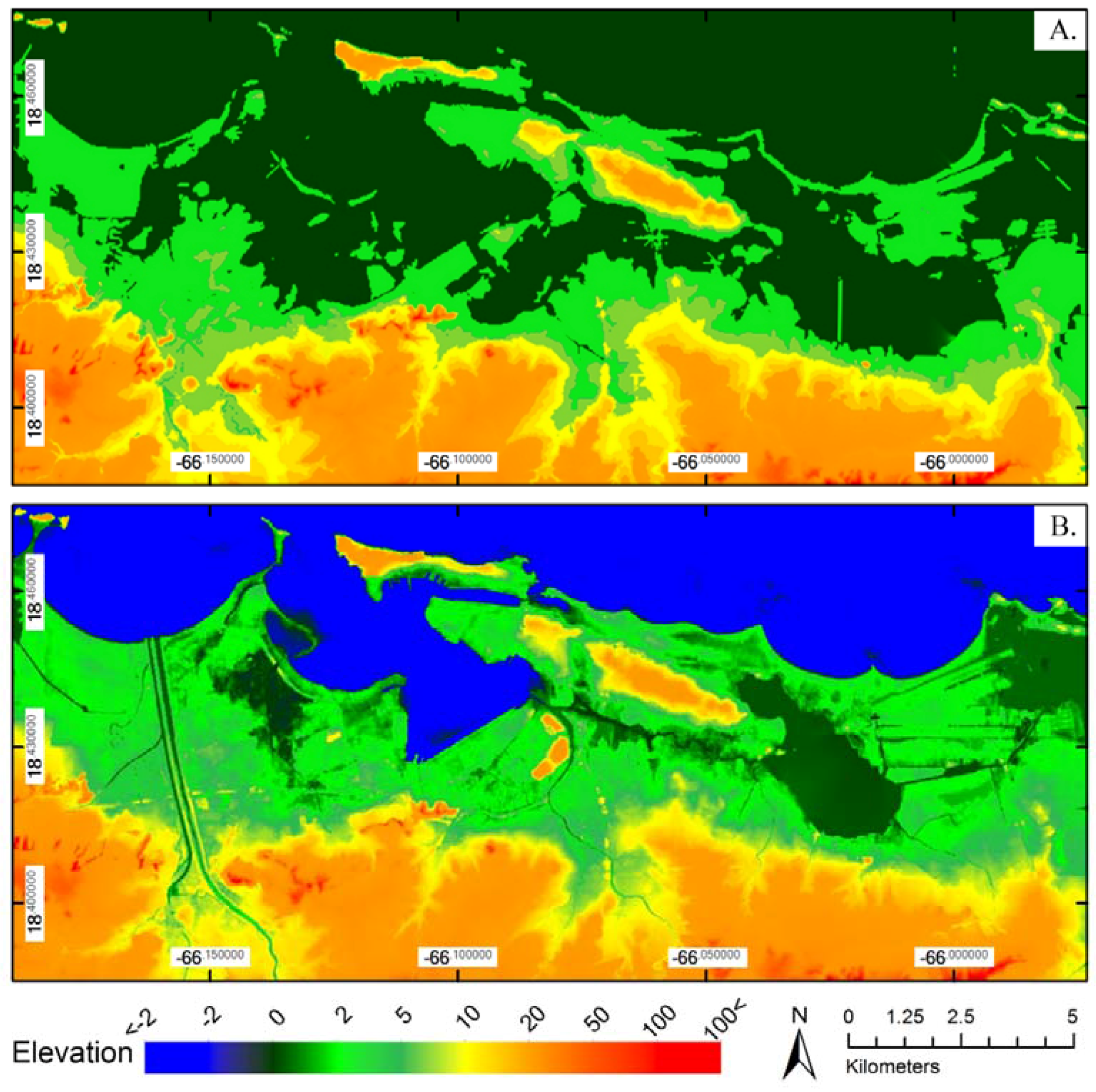

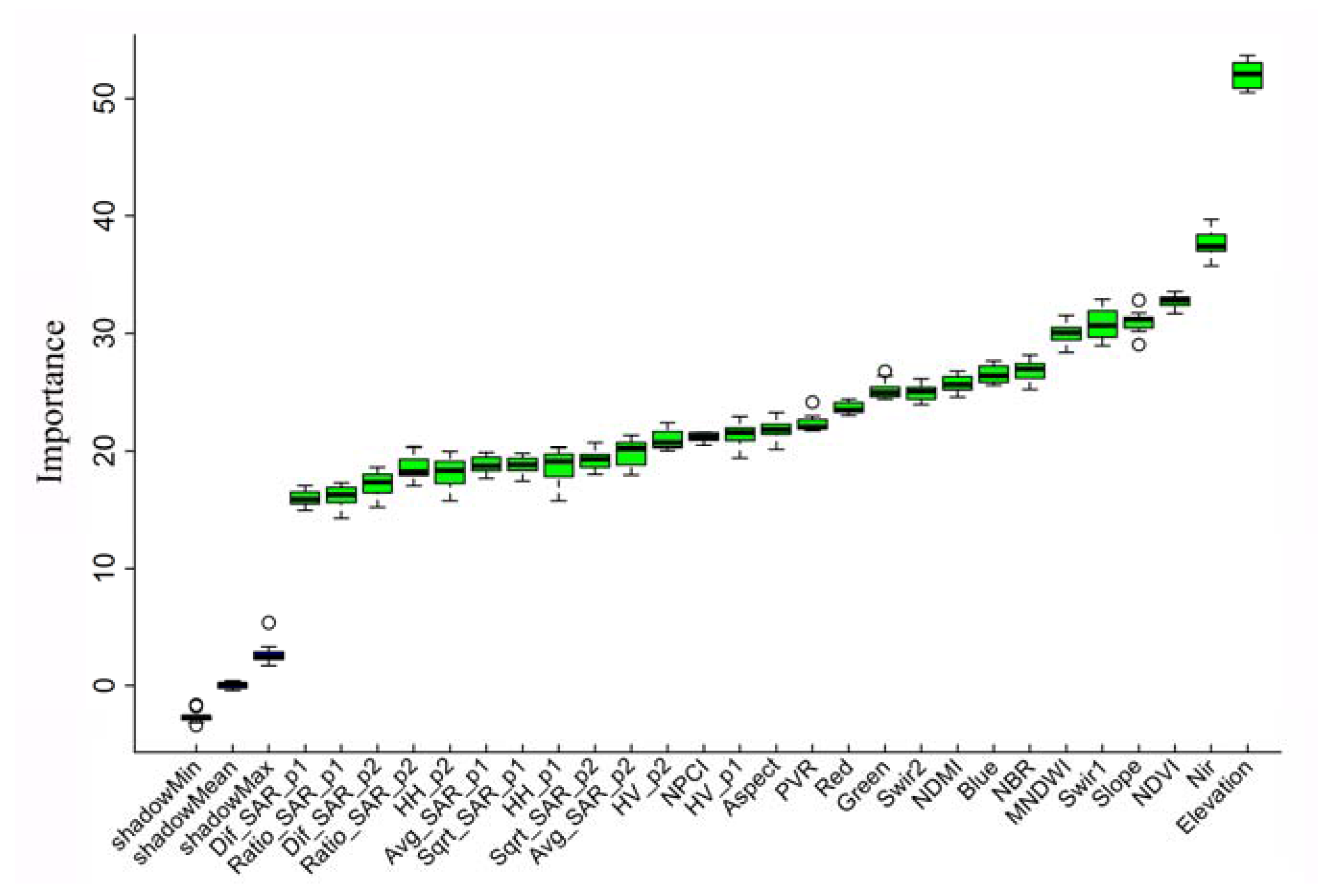
References
- Dixon, R.K.; Brown, S.; Houghton, R.A.; Solomon, A.M.; Trexler, M.C.; Wisniewski, J. Carbon pools and flux of global forest ecosystems. Science 1994, 263, 185–190. [Google Scholar] [CrossRef] [PubMed]
- Bonan, G.B. Forests and climate change: Forcings, feedbacks, and the climate benefits of forests. Science 2008, 320, 1444–1449. [Google Scholar] [CrossRef] [PubMed]
- Foley, J.A.; DeFries, R.; Asner, G.P.; Barford, C.; Bonan, G.; Carpenter, S.R.; Chapin, F.S.; Coe, M.T.; Daily, G.C.; Gibbs, H.K.; et al. Global consequences of land use. Science 2005, 309, 570–574. [Google Scholar] [CrossRef] [PubMed]
- Foster, A.D.; Rosenzweig, M.R. Economic growth and the rise of forests. Q. J. Econ. 2003, 118, 601–637. [Google Scholar] [CrossRef]
- Chazdon, R.L. Beyond deforestation: Restoring forests and ecosystem services on degraded lands. Science 2008, 320, 1458–1460. [Google Scholar] [CrossRef] [PubMed]
- Gibbs, H.K.; Ruesch, A.S.; Achard, F.; Clayton, M.K.; Holmgren, P.; Ramankutty, N.; Foley, J.A. Tropical forests were the primary sources of new agricultural land in the 1980s and 1990s. Proc. Natl. Acad. Sci. USA 2010, 107, 16732–16737. [Google Scholar] [CrossRef] [PubMed]
- Hansen, M.C.; Potapov, P.V.; Moore, R.; Hancher, M.; Turubanova, S.A.; Tyukavina, A.; Thau, D.; Stehman, S.V.; Goetz, S.J.; Loveland, T.R.; et al. High–resolution global maps of 21st-century forest cover change. Science 2013, 342, 850–853. [Google Scholar] [CrossRef] [PubMed]
- Achard, F.; Beuchle, R.; Mayaux, P.; Stibig, H.J.; Bodart, C.; Brink, A.; Carboni, S.; Desclee, B.; Donnay, F.; Eva, H.D.; et al. Determination of tropical deforestation rates and related carbon losses from 1990 to 2010. Glob. Chang. Biol. 2014, 20, 2540–2554. [Google Scholar] [CrossRef] [PubMed]
- Shimada, M.; Itoh, T.; Motooka, T.; Watanabe, M.; Shiraishi, T.; Thapa, R.; Lucas, R. New global forest/non-forest maps from alos palsar data (2007–2010). Remote Sens. Environ. 2014, 155, 13–31. [Google Scholar] [CrossRef]
- Food and Agriculture Organization of the United Nations. Global Forest Resources Assessment Main Report: Fao Forestry Paper #163; FAO: Rome, Italy, 2010. [Google Scholar]
- Potapov, P.V.; Turubanova, S.A.; Tyukavina, A.; Krylov, A.M.; McCarty, J.L.; Radeloff, V.C.; Hansen, M.C. Eastern europe’s forest cover dynamics from 1985 to 2012 quantified from the full landsat archive. Remote Sens. Environ. 2015, 159, 28–43. [Google Scholar] [CrossRef]
- Gutman, G.; Huang, C.; Chander, G.; Noojipady, P.; Masek, J.G. Assessment of the nasa–usgs global land survey (gls) datasets. Remote Sens. Environ. 2013, 134, 249–265. [Google Scholar] [CrossRef]
- Ban, Y.; Gong, P.; Giri, C. Global land cover mapping using earth observation satellite data: Recent progresses and challenges. ISPRS J. Photogramm. Remote Sens. 2015, 103, 1–6. [Google Scholar] [CrossRef]
- Wang, C.; Gao, Q.; Wang, X.; Yu, M. Decadal trend in agricultural abandonment and woodland expansion in an agro-pastoral transition band in northern china. PLoS ONE 2015, 10, e0142113. [Google Scholar] [CrossRef] [PubMed]
- Qin, Y.; Xiao, X.; Dong, J.; Zhang, G.; Shimada, M.; Liu, J.; Li, C.; Kou, W.; Moore, B. Forest cover maps of china in 2010 from multiple approaches and data sources: Palsar, landsat, modis, fra, and nfi. ISPRS J. Photogramm. Remote Sens. 2015, 109, 1–16. [Google Scholar] [CrossRef]
- Wulder, M.A.; Dechka, J.A.; Gillis, M.A.; Luther, J.E.; Hall, R.J.; Beaudoin, A.; Franklin, S.E. Operational mapping of the land cover of the forested area of canada with landsat data: Eosd land cover program. For. Chron. 2003, 79, 1075–1083. [Google Scholar] [CrossRef]
- Dong, J.; Xiao, X.; Chen, B.; Torbick, N.; Jin, C.; Zhang, G.; Biradar, C. Mapping deciduous rubber plantations through integration of palsar and multi-temporal landsat imagery. Remote Sens. Environ. 2013, 134, 392–402. [Google Scholar] [CrossRef]
- Yu, M.; Gao, Q.; Gao, C.; Wang, C. Extent of night warming and spatially heterogeneous cloudiness differentiate temporal trend of greenness in mountainous tropics in the new century. Sci. Rep. 2017, 7, 41256. [Google Scholar] [CrossRef] [PubMed]
- Lehmann, E.A.; Caccetta, P.; Lowell, K.; Mitchell, A.; Zhou, Z.-S.; Held, A.; Milne, T.; Tapley, I. Sar and optical remote sensing: Assessment of complementarity and interoperability in the context of a large-scale operational forest monitoring system. Remote Sens. Environ. 2015, 156, 335–348. [Google Scholar] [CrossRef]
- Dobson, M.C.; Ulaby, F.T. Active microwave soil moisture research. IEEE Trans. Geosci. Remote Sens. 1986, 24, 23–36. [Google Scholar] [CrossRef]
- Motohka, T.; Shimada, M.; Uryu, Y.; Setiabudi, B. Using time series palsar gamma nought mosaics for automatic detection of tropical deforestation: A test study in riau, indonesia. Remote Sens. Environ. 2014, 155, 79–88. [Google Scholar] [CrossRef]
- Forkuor, G.; Conrad, C.; Thiel, M.; Ullmann, T.; Zoungrana, E. Integration of optical and synthetic aperture radar imagery for improving crop mapping in Northwestern Benin, West Africa. Remote Sens. 2014, 6, 6472–6499. [Google Scholar] [CrossRef]
- Myers, N.; Mittermeier, R.A.; Mittermeier, C.G.; da Fonseca, G.A.B.; Kent, J. Biodiversity hotspots for conservation priorities. Nature 2000, 403, 853–858. [Google Scholar] [CrossRef] [PubMed]
- Helmer, E.; Ramos, O.; del MLópez, T.; Quiñónez, M.; Diaz, W. Mapping the forest type and land cover of puerto rico, a component of the caribbean biodiversity hotspot. Caribb. J. Sci. 2002, 38, 165–183. [Google Scholar]
- Rudel, T.K.; Perez-Lugo, M.; Zichal, H. When fields revert to forest: Development and spontaneous reforestation in post-war puerto rico. Prof. Geogr. 2000, 52, 386–397. [Google Scholar] [CrossRef]
- Dietz, J.L. Economic history of puerto rico: Institutional change and capitalist development; Princeton University Press: Princeton, NJ, USA, 1986. [Google Scholar]
- Grau, H.R.; Aide, T.M.; Zimmerman, J.K.; Thomlinson, J.R.; Helmer, E.; Zou, X. The ecological consequences of socioeconomic and land-use changes in postagriculture puerto rico. BioScience 2003, 53, 1159–1168. [Google Scholar] [CrossRef]
- Lugo, A.E.; Helmer, E. Emerging forests on abandoned land: Puerto rico’s new forests. For. Ecol. Manag. 2004, 190, 145–161. [Google Scholar] [CrossRef]
- Kennaway, T.; Helmer, E.H. The forest types and ages cleared for land development in puerto rico. GIScience Remote Sens. 2007, 44, 356–382. [Google Scholar] [CrossRef]
- Pares-Ramos, I.K.; Gould, W.A.; Aide, T.M. Agricultural abandonment, suburban growth, and forest expansion in puerto rico between 1991 and 2000. Ecol. Soc. 2008, 13, 288–297. [Google Scholar] [CrossRef]
- Gao, Q.; Yu, M. Discerning fragmentation dynamics of tropical forest and wetland during reforestation, urban sprawl, and policy shifts. PLoS ONE 2014, 9, e113140. [Google Scholar] [CrossRef] [PubMed]
- Martinuzzi, S.; Gould, W.A.; Gonzalez, O.M.R. Land development, land use, and urban sprawl in puerto rico integrating remote sensing and population census data. Landsc. Urban Plan. 2007, 79, 288–297. [Google Scholar] [CrossRef]
- Daly, C.; Helmer, E.H.; Quiñones, M. Mapping the climate of puerto rico, vieques and culebra. Int. J. Climatol. 2003, 23, 1359–1381. [Google Scholar] [CrossRef]
- Gould, W.A.; Alarcón, C.; Fevold, B.; Jiménez, M.E.; Martinuzzi, S.; Potts, G.; Quiñones, M.; Solórzano, M.; Ventosa, E. The puerto rico gap analysis project. In International Institute of Tropical Forestry General Technical Report IITF-GTR-39; USDA Forest Service: San Juan, Puerto Rico, 2008. [Google Scholar]
- Olson, D.M.; Dinerstein, E.; Wikramanayake, E.D.; Burgess, N.D.; Powell, G.V.N.; Underwood, E.C.; D’Amico, J.A.; Itoua, I.; Strand, H.E.; Morrison, J.C.; et al. Terrestrial ecoregions of the world: A new map of life on earth. Bioscience 2001, 51, 933–938. [Google Scholar] [CrossRef]
- Zhu, Z.; Woodcock, C.E. Object-based cloud and cloud shadow detection in landsat imagery. Remote Sens. Environ. 2012, 118, 83–94. [Google Scholar] [CrossRef]
- Housman, I.; Tanpipat, V.; Biswas, T.; Clark, A.; Stephen, P.; Maus, P.; Megown, K. Monitoring forest change in southeast asia: Case studies for usaid lowering emissions in asia’s forests; U.S. Department of Agriculture, Forest Service, Remote Sensing Applications Center: Salt Lake City, Utah, 2015; pp. 1–16.
- Gesch, D. The national elevation dataset. In digital elevation model technologies and applications: The DEM users manual 2nd ed.; American Society for Photogrammetry and Remote Sensing: Bethesda, MD, USA, 2007; pp. 99–918. [Google Scholar]
- Taylor, L.; Eakins, B.; Carignan, K.; Warnken, R.; Sazonova, T.; Schoolcraft, D. Digital elevation models of puerto rico: Procedures, data sources and analysis; NOAA Technical Memorandum NESDIS NGDC-13; National Geophysical Data Center: Boulder, Colorado, USA, 2008.
- Helmer, E.H.; Ruefenacht, B. Cloud-free satellite image mosaics with regression trees and histogram matching. Photogramm. Eng. Remote Sens. 2005, 71, 1079–1089. [Google Scholar] [CrossRef]
- Puerto Rico Government. Portal of government Geographic Data. Available online: www.gis.pr.gov (accessed on 22 April 2017).
- Cutler, D.R.; Edwards Jr, T.C.; Beard, K.H.; Cutler, A.; Hess, K.T.; Gibson, J.; Lawler, J.J. Random forests for classification in ecology. Ecology 2007, 88, 2783–2792. [Google Scholar] [CrossRef] [PubMed]
- Zhu, Z.; Woodcock, C.E.; Rogan, J.; Kellndorfer, J. Assessment of spectral, polarimetric, temporal, and spatial dimensions for urban and peri-urban land cover classification using landsat and sar data. Remote Sens. Environ. 2012, 117, 72–82. [Google Scholar] [CrossRef]
- Bourgeau-Chavez, L.; Endres, S.; Battaglia, M.; Miller, M.; Banda, E.; Laubach, Z.; Higman, P.; Chow-Fraser, P.; Marcaccio, J. Development of a bi-national great lakes coastal wetland and land use map using three-season palsar and landsat imagery. Remote Sens. 2015, 7, 8655–8682. [Google Scholar] [CrossRef]
- Kursa, M.B.; Rudnicki, W.R. Feature selection with the boruta package. J. Stat. Softw. 2010, 36, 1–13. [Google Scholar]
- Puyravaud, J.-P. Standardizing the calculation of the annual rate of deforestation. For. Ecol. Manag. 2003, 177, 593–596. [Google Scholar]
- Anderegg, W.R.L.; Ballantyne, A.P.; Smith, W.K.; Majkut, J.; Rabin, S.; Beaulieu, C.; Birdsey, R.; Dunne, J.P.; Houghton, R.A.; Myneni, R.B.; et al. Tropical nighttime warming as a dominant driver of variability in the terrestrial carbon sink. Proc. Natl. Acad. Sci. USA 2015, 112, 15591–15596. [Google Scholar] [CrossRef] [PubMed]
- Chen, D.; Yu, M.; González, G.; Zou, X.; Gao, Q. Climate impacts on soil carbon processes along an elevation gradient in the tropical luquillo experimental forest. Forests 2017, 8, 90. [Google Scholar] [CrossRef]
- Masek, J.G.; Vermote, E.F.; Saleous, N.E.; Wolfe, R.; Hall, F.G.; Huemmrich, K.F.; Feng, G.; Kutler, J.; Teng-Kui, L. A landsat surface reflectance dataset for north america, 1990-2000. IEEE Geosci. Remote Sens. Lett. 2006, 3, 68–72. [Google Scholar] [CrossRef]
- U.S. Census Bureau. U.S. Census bureau Censtats Databases. Available online: http://www.Census.Gov/ (accessed on 22 April 2017).
- The World Bank—World Development Indicators. Forest Area as a Percentage of land Area, Source from Food and Agriculture Organization. Available online: http://data.worldbank.org/indicator/AG.LND.FRST.ZS?locations=PR (accessed on 22 April 2017).
- Homer, C.; Dewitz, J.; Yang, L.; Jin, S.; Danielson, P.; Xian, G.; Coulston, J.; Herold, N.; Wickham, J.; Megown, K. Completion of the 2011 national land cover database for the conterminous united states—Representing a decade of land cover change information. Photogramm. Eng. Remote Sens. 2015, 81, 345–354. [Google Scholar]
- Álvarez-Berríos, N.; Redo, D.; Aide, T.; Clark, M.; Grau, R. Land change in the greater antilles between 2001 and 2010. Land 2013, 2, 81–107. [Google Scholar] [CrossRef]
- Gao, Q.; Yu, M. Reforestation-induced changes of landscape composition and configuration modulate freshwater supply and flooding risk of tropical watersheds. PLoS ONE 2017, 12, e0181315. [Google Scholar] [CrossRef]
- Brokaw, N.V.L.; Walker, L.R. Summary of the effects of caribbean hurricanes on vegetation. Biotropica 1991, 23, 442–447. [Google Scholar] [CrossRef]
- Comita, L.S.; Uriarte, M.; Thompson, J.; Jonckheere, I.; Canham, C.D.; Zimmerman, J.K. Abiotic and biotic drivers of seedling survival in a hurricane-impacted tropical forest. J. Ecol. 2009, 97, 1346–1359. [Google Scholar] [CrossRef]
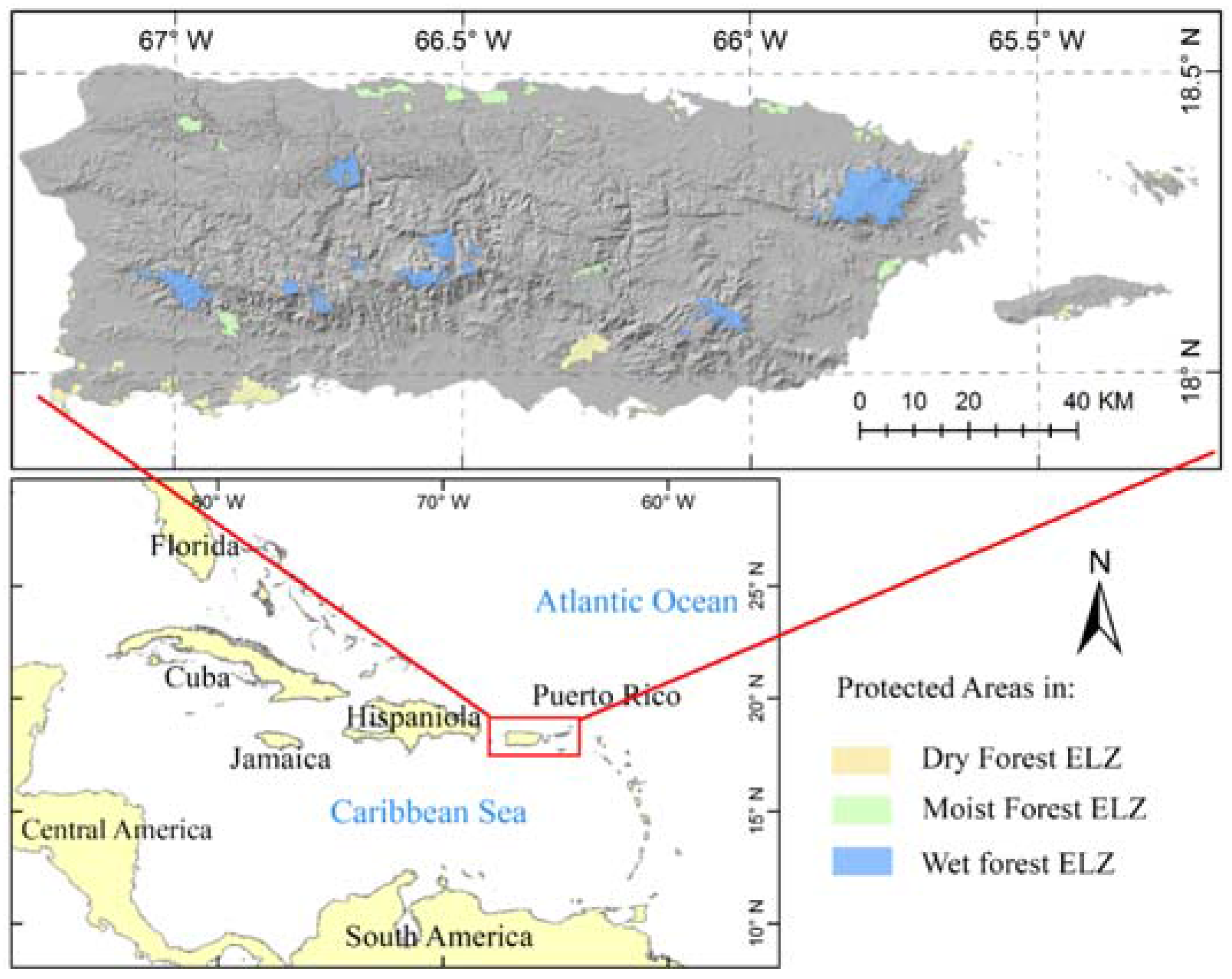
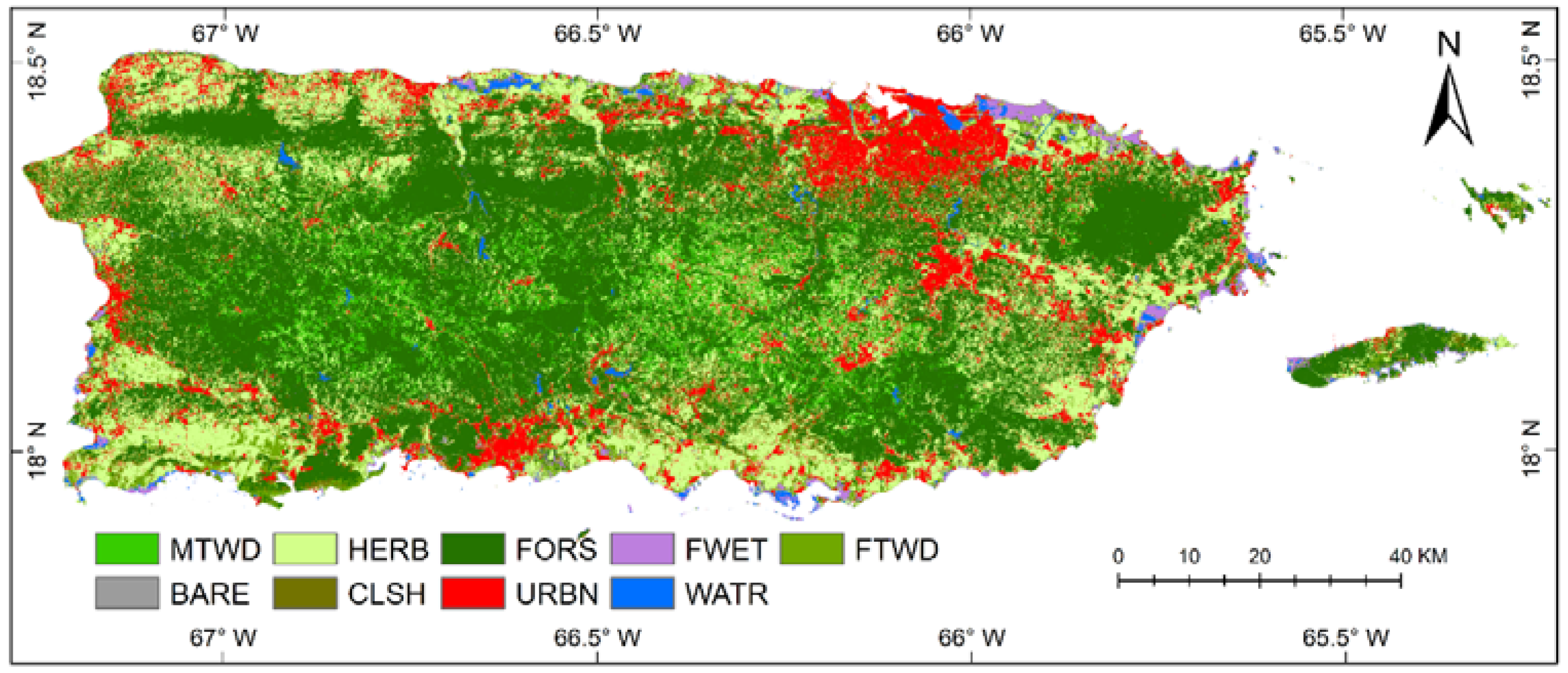
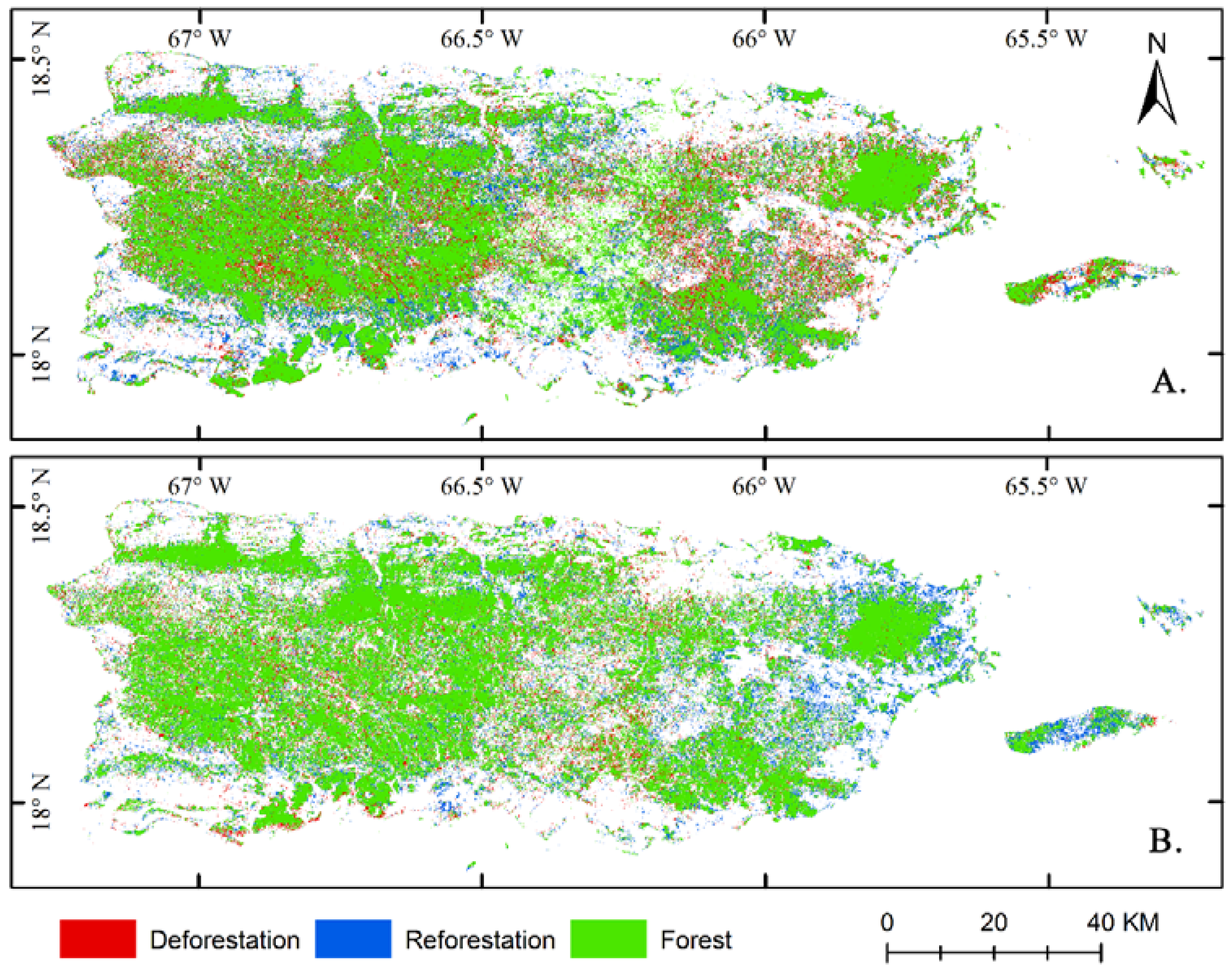
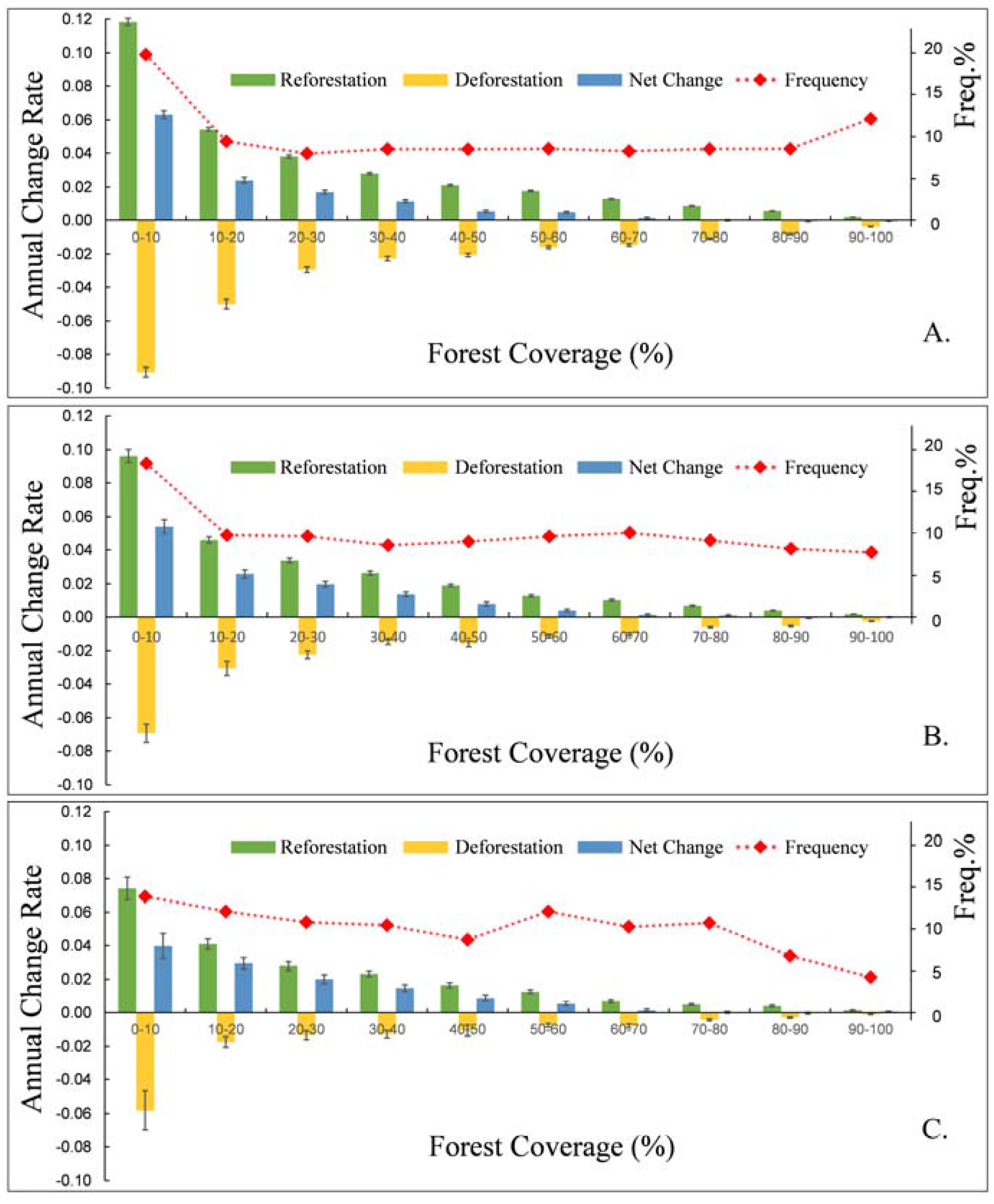
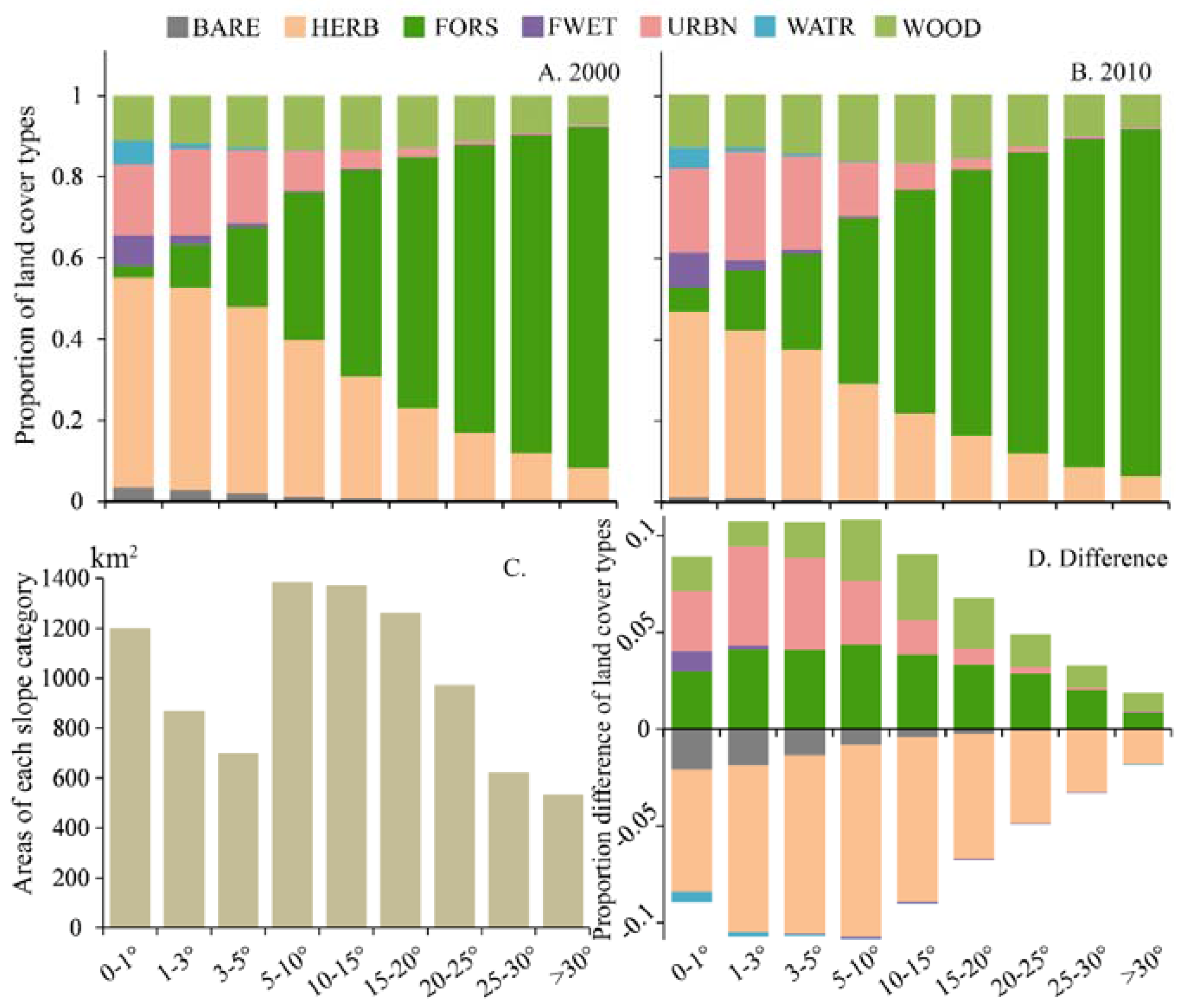
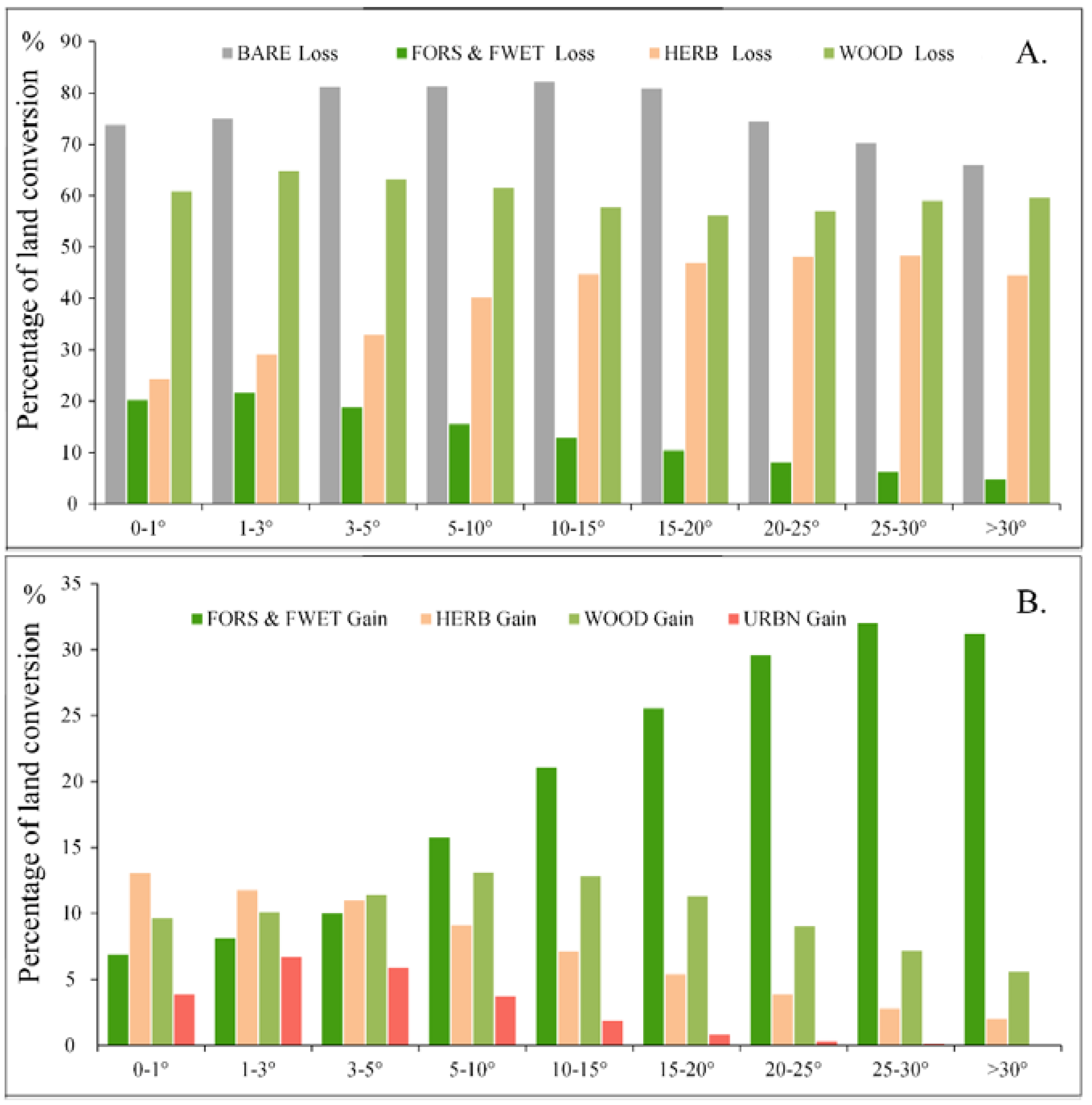
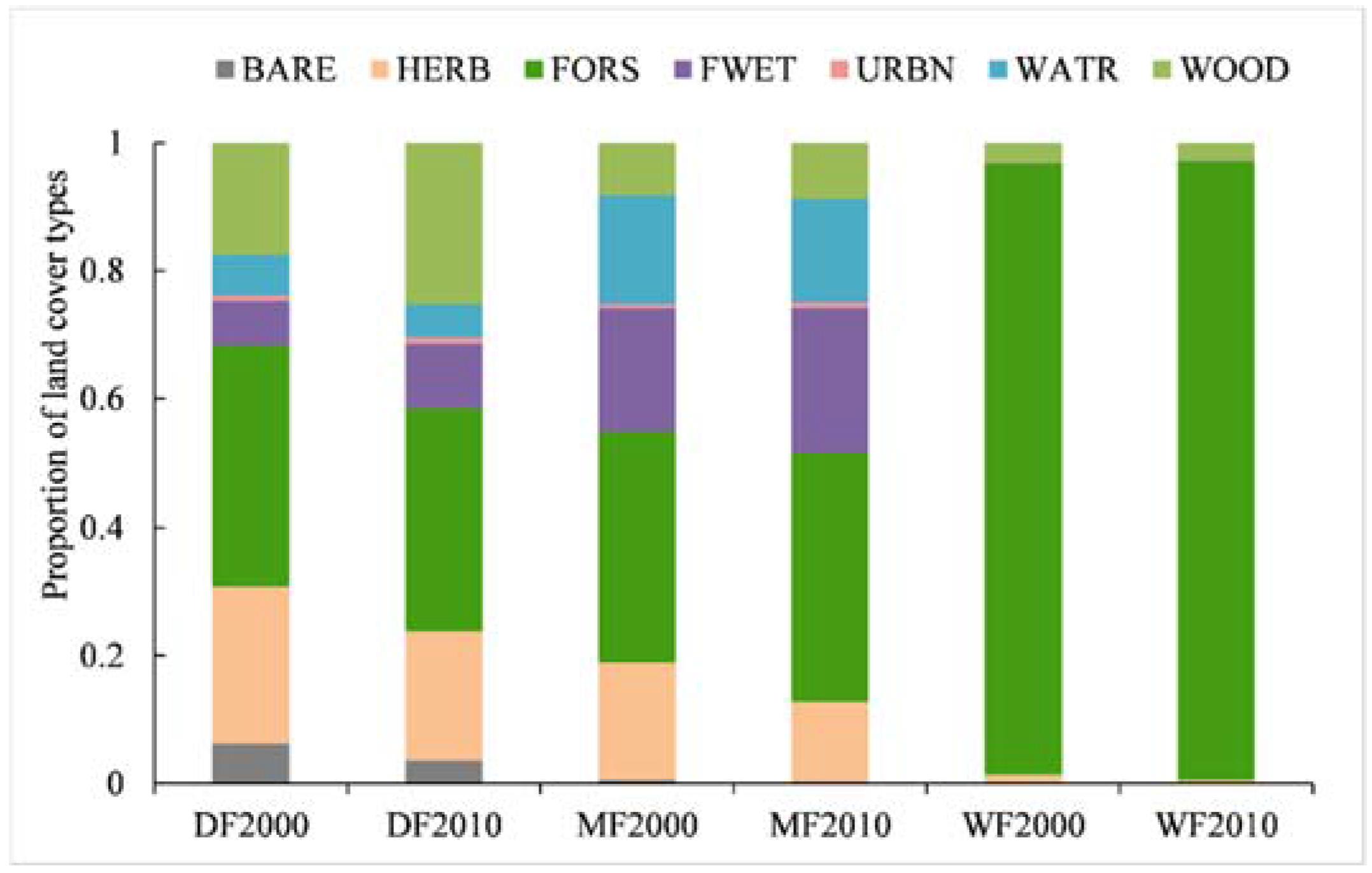
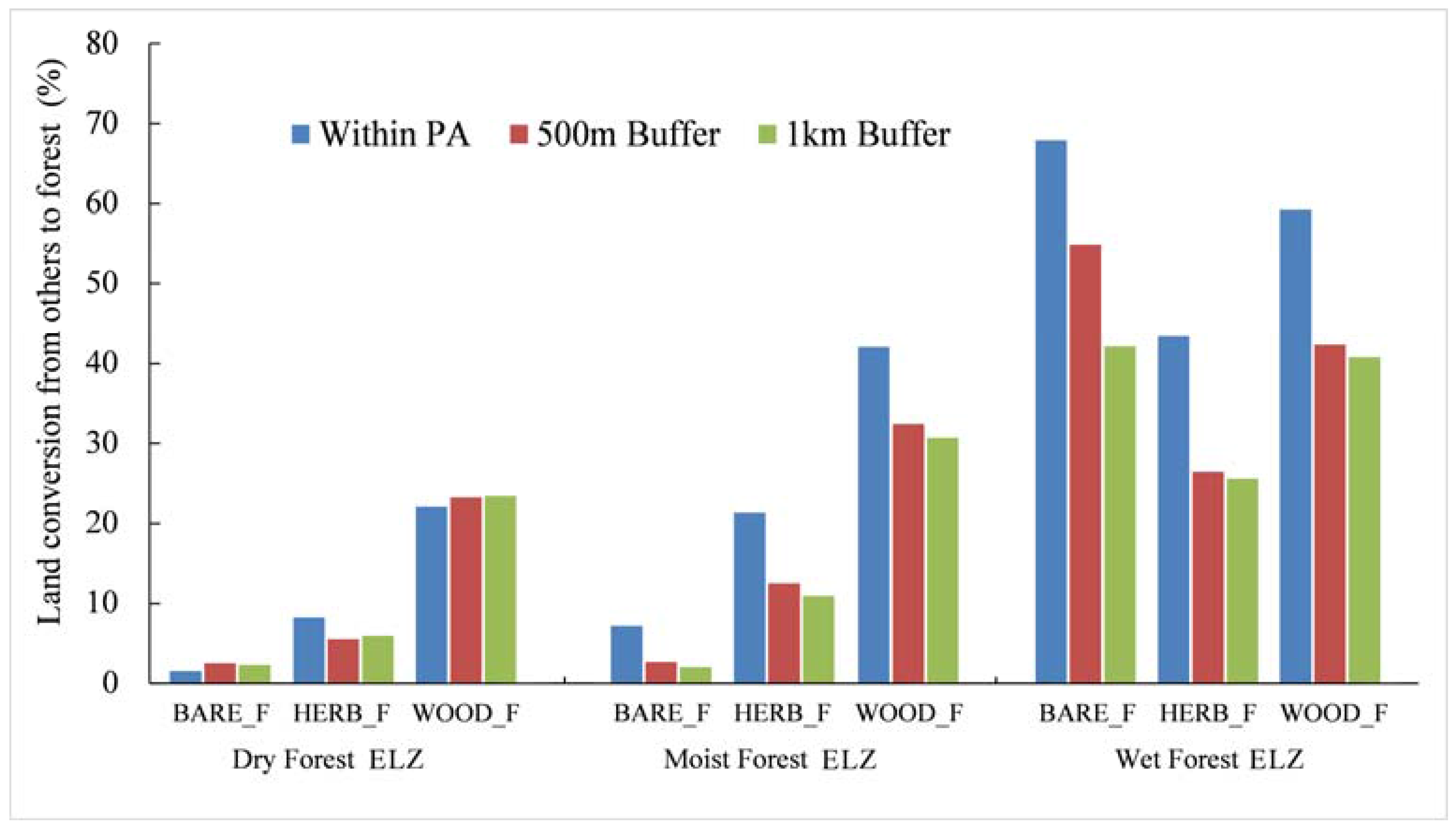
| Producer’s Accuracy (%) | User’s Accuracy (%) | |||||||||
|---|---|---|---|---|---|---|---|---|---|---|
| 2000 | C1 | C2 | C3 | C1 | C2 | C3 | ||||
| MTWD | 85.0 | 85.0 | 85.0 | 89.5 | 94.4 | 85.0 | ||||
| BARE | 90.0 | 96.7 | 93.3 | 100.0 | 93.5 | 96.6 | ||||
| CLSH | 60.0 | 80.0 | 66.7 | 69.2 | 92.3 | 83.3 | ||||
| FORS | 91.4 | 91.4 | 91.9 | 95.0 | 94.4 | 94.5 | ||||
| HERB | 95.7 | 95.1 | 97.5 | 93.4 | 93.3 | 91.9 | ||||
| URBN | 98.3 | 96.6 | 94.8 | 93.4 | 96.6 | 98.2 | ||||
| FWET | 96.4 | 96.4 | 98.2 | 89.8 | 89.8 | 93.1 | ||||
| WATR | 100.0 | 100.0 | 100.0 | 100.0 | 100.0 | 100.0 | ||||
| FTWD | 62.9 | 65.7 | 77.1 | 59.5 | 62.2 | 81.8 | ||||
| OA (%) | 91.3 | 92.0 | 93.0 | |||||||
| Kappa (%) | 88.4 | 89.4 | 90.8 | |||||||
| 2010 | C1 | C2 | C3 | C4 | C5 | C1 | C2 | C3 | C4 | C5 |
| MTWD | 90.7 | 90.7 | 93.0 | 88.4 | 93.0 | 90.7 | 90.7 | 93.0 | 92.7 | 95.2 |
| BARE | 77.8 | 100.0 | 100.0 | 100.0 | 100.0 | 77.8 | 75.0 | 90.0 | 75.0 | 90.0 |
| CLSH | 73.3 | 66.7 | 66.7 | 66.7 | 70.0 | 75.9 | 80.0 | 71.4 | 66.7 | 70.0 |
| FORS | 96.2 | 95.7 | 96.2 | 96.2 | 96.8 | 93.2 | 93.7 | 95.7 | 94.7 | 94.7 |
| HERB | 93.3 | 93.3 | 96.4 | 95.3 | 96.9 | 92.8 | 92.8 | 90.7 | 94.4 | 94.0 |
| URBN | 88.4 | 93.0 | 76.7 | 93.0 | 90.7 | 82.6 | 87.0 | 89.2 | 100.0 | 100.0 |
| FWET | 93.9 | 93.9 | 93.9 | 93.9 | 93.9 | 100.0 | 100.0 | 97.9 | 95.8 | 97.9 |
| WATR | 100.0 | 100.0 | 100.0 | 100.0 | 100.0 | 100.0 | 100.0 | 100.0 | 100.0 | 100.0 |
| FTWD | 57.6 | 63.6 | 63.6 | 72.7 | 63.6 | 70.4 | 70.0 | 72.4 | 77.4 | 72.4 |
| OA (%) | 90.8 | 91.3 | 91.5 | 92.5 | 93.0 | |||||
| Kappa (%) | 87.5 | 88.2 | 88.4 | 89.9 | 90.5 | |||||
| 2010 | ||||||
|---|---|---|---|---|---|---|
| 2000 | BARE | HERB | FORE | URBN | WATR | WOOD |
| BARE | 26.3 | 35.6 | 2.9 | 34.0 | 5.6 | 7.4 |
| HERB | 7.5 | 1835.5 | 374.8 | 142.9 | 4.2 | 517.2 |
| FORE | 1.6 | 123.5 | 3561.1 | 7.0 | 3.4 | 297.0 |
| URBN | 0.2 | 2.0 | 0.02 | 760.4 | 0 | 1.2 |
| WATR | 1.7 | 3.4 | 13.5 | 0.5 | 66.0 | 5.6 |
| WOOD | 1.5 | 257.8 | 352.8 | 17.8 | 1.2 | 425.7 |
| LC Type | Overall | DF | MF | WF | ||||
|---|---|---|---|---|---|---|---|---|
| Inside PA | ||||||||
| BARE | −3.7 | (−44.4%) | −3.2 | (−42.3%) | −0.4 | (−56.3%) | −0.1 | (−98.6%) |
| HERB | −14.4 | (−25.8%) | −5.2 | (−17.7%) | −7.0 | (−31.3%) | −2.1 | (−56.1%) |
| FORS | 3.6 | (1.0%) | −3.4 | (−7.4%) | 3.6 | (8.1%) | 3.4 | (1.3%) |
| FWET | 7.7 | (23.8%) | 3.7 | (43.6%) | 4.0 | (17.0%) | −0.04 | (−35.7%) |
| URBN | 0.4 | (19.4%) | 0.1 | (11.6%) | 0.3 | (30.2%) | 0.04 | (15.4%) |
| WATR | −2.4 | (−8.4%) | −1.3 | (−17.3%) | −1.1 | (−5.1%) | −0.02 | (−45.2%) |
| WOOD | 8.8 | (22.1%) | 9.3 | (43.8%) | 0.7 | (6.8%) | −1.2 | (−13.4%) |
| 500 m buffer outside PA | ||||||||
| BARE | −5.1 | (−60.5%) | −2.4 | (−59.0%) | −2.5 | (−60.5%) | −0.2 | (−96.1%) |
| HERB | 30.0 | (−23.3%) | −6.8 | (−16.0%) | −14.4 | (−22.7%) | −8.8 | (−38.6%) |
| FORS | 15.2 | (6.4%) | 1.8 | (9.3%) | 6.0 | (9.4%) | 7.5 | (4.8%) |
| FWET | 2.3 | (14.7%) | 1.5 | (25.3%) | 1.1 | (11.6%) | −0.3 | (−65.6%) |
| URBN | 7.2 | (23.8%) | 1.8 | (19.7%) | 5.1 | (26.3%) | 0.4 | (18.4%) |
| WATR | −0.8 | (−7.7%) | −0.7 | (−15.2%) | 0.0 | (<0.1%) | −0.04 | (−4.9%) |
| WOOD | 11.1 | (18.1%) | 5.0 | (25.3%) | 4.7 | (25.4%) | 1.4 | (6.1%) |
| 1 km buffer outside PA | ||||||||
| BARE | −9.2 | (−60.9%) | −4.5 | (−61.5%) | −4.4 | (−59.2%) | −0.3 | (−87.6%) |
| HERB | −62.4 | (−23.0%) | −15.7 | (−17.0%) | −28.1 | (−22.0%) | −18.7 | (−35.9%) |
| FORS | 30.0 | (7.0%) | 5.0 | (14.3%) | 10.4 | (8.5%) | 14.5 | (5.3%) |
| FWET | 3.0 | (13.3%) | 2.4 | (29.5%) | 1.1 | (7.9%) | −0.5 | (−60.2%) |
| URBN | 16.1 | (24.7%) | 4.1 | (22.8%) | 11.2 | (25.9%) | 0.8 | (20.7%) |
| WATR | −1.2 | (−9.0%) | −0.9 | (−14.3%) | −0.2 | (−3.8%) | −0.1 | (−6.7%) |
| WOOD | 23.6 | (19.7%) | 9.6 | (24.9%) | 9.9 | (27.2%) | 4.2 | (9.2%) |
© 2017 by the authors. Licensee MDPI, Basel, Switzerland. This article is an open access article distributed under the terms and conditions of the Creative Commons Attribution (CC BY) license (http://creativecommons.org/licenses/by/4.0/).
Share and Cite
Wang, C.; Yu, M.; Gao, Q. Continued Reforestation and Urban Expansion in the New Century of a Tropical Island in the Caribbean. Remote Sens. 2017, 9, 731. https://doi.org/10.3390/rs9070731
Wang C, Yu M, Gao Q. Continued Reforestation and Urban Expansion in the New Century of a Tropical Island in the Caribbean. Remote Sensing. 2017; 9(7):731. https://doi.org/10.3390/rs9070731
Chicago/Turabian StyleWang, Chao, Mei Yu, and Qiong Gao. 2017. "Continued Reforestation and Urban Expansion in the New Century of a Tropical Island in the Caribbean" Remote Sensing 9, no. 7: 731. https://doi.org/10.3390/rs9070731
APA StyleWang, C., Yu, M., & Gao, Q. (2017). Continued Reforestation and Urban Expansion in the New Century of a Tropical Island in the Caribbean. Remote Sensing, 9(7), 731. https://doi.org/10.3390/rs9070731





